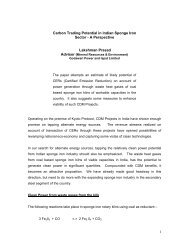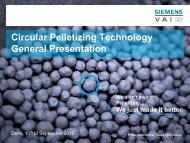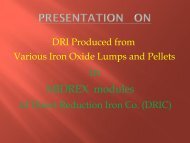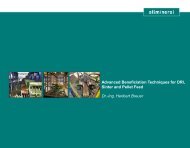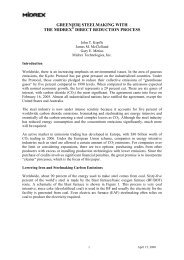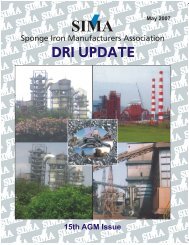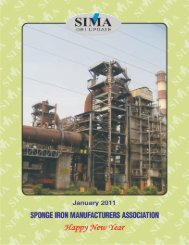Raw material availability:Basic raw material for EAF/IF steel making is providedby the sponge iron industry, which includes coalbased and gas based DRI manufacturers. However,basic raw material insecurity will remain and as thedirect out come of that Sponge iron industry willcontinue to face the uncertainty of raw material likeiron ore, coal etc. until some sustained governmentpolicy is drawn in favor of this particular industry orindustry players form a strong consortium to handleraw material issue jointly.The expected growth in steel making from DRI isshown in Break up of the Projected Crude SteelCapacity shown in the following Table:Break up of the Projected Crude Steel Capacity (in ‘000 MT)Production origin Year : <strong>2011</strong>-12 Year : 2016-17 Year : 2019-20Crude Steel from Hot Metal 54000 96000 120000Crude Steel from DRI 29700 52800 66000Crude Steel from Scrap 6300 11200 14000Total 90000 160000 200000Source : MECON published DataConsidering the projected capacity of steel makingusing DRI it could be worked out that, Sponge ironIndustry alone, to feed IF/EAF, will require to producerequired DRI (Assuming coal based DRI productionat approximately 40 mil. MT per annum by year 2016-17), almost 70 mil. MT of Iron ore or substitute andmore than 60 mil. MT of coal as reducing agent inDRI Kilns by the end of next five year plan i.e. in theyear 2016-17. The basic raw material scenario asexpected to emerge in future is elaborated as follows:Iron Ore: Presently annual domestic demand of ironore stand at almost 95 mil. MT (Lumps consumptionis almost 85 mil. MT and rest are fines), growing atCAGR of 12%. India is the fourth largest producer ofiron ore, producing around 220 mil MT iron ore in Fy10. The country takes the sixth position in terms ofworld-wide reserve but due to insufficient exploration,has a very lower Reserve : Production (R/P) ratio of111 compared to other producing countries like Brazil(184), Australia (134). Selective exploitation of highgrade reserve (64% and above) in the past globaldemand buoyancy led to the present deterioration inquality – low grade generating almost 55% fineswhich is not used by Indian steel manufacturer andultimately, land on ships for exports in large scale.Sponge iron producers thus are dependent on themercy of private miners for supply as most of themare not allotted captive mines and compelled to payhigh prices for inferior quality (Fe content of 60% oreven lower mixed with fines and dust in excess ratio).Linkage of domestic price to international priceescalates the hardship further. However, recent spurtin investment in setting up pelletization plants to usefines is expected to give some hope of relief fromthis uncertainty.Coal: Presently sponge iron industry requires almost30 mil. MT of non-coking coal of “B” or “C” grade, asin Fy-10, against supply of about 20 mil. MT (including5-6 mil. MT of captive mines allotted to a few largeroperators) leaving a big short fall. In the process ofcoal based sponge iron production, for each MT ofsteel, coal requirement is almost 1.6 MT, if quality isgood. Due to scarcity, operators often forced to useinferior coal incurring higher non-sustainable cost ofproduction, leaving scanty margin or negative.Gas: Non-availability in sufficiency and irrationalpricing led to uncertainty and prevented any furthercapacity addition in gas based DRI production in thelast several years. Things are improving now withmore discovery, enhancement in pipe distributionnetwork and could encourage further capacityDECEMBER-<strong>2011</strong>/14
addition or transformation from coal based in futureas the process is comparatively greener.Steel scrap : Uncertainty in availability and the pricefluctuation is always a concern. Indigenouslyavailable volume is not sufficient and thus dependson imported scrap, the prices of which are linked withinternational trade price and longer supply cycle andthus often not viable compared with substitute likesponge iron which is available aplenty. However,near-to-the port areas like Punjab, Large portion ofMaharashtra consume scrap in higher proportion dueto freight advantage.Another important input for this industry is of coursethe electricity, cost and seasonal scarcity is equallyan important concern of this industry. However, largeplayers who are backward-integrated formanufacturing sponge iron for self use are equippingthemselves to coproduce excess power by wasteheat recovery from sponge iron kilns in case of coalbased process. Another common problem is lack ofavailability of quality infrastructure and logistics,including railway rakes, often off setting cost structureand that will definitely concern all stakeholders in thesteel industry and might affect the growth prospectof the industry by creating a stumbling block.Other factors, those could be related to technologyparity, as it would become demanding for complyingwith increasingly stricter environmental regulationsand compulsion for improvement in product qualityto some standard level to ensure production of qualitysteel through these popular electrical process andalso the threat of substitute raw material, like scrapwhich often destabilize the commercial viability, willalso remain as major challenging points for thesponge iron industry and so will be the InductionFurnace industry.STEEL MAKING WITH COAL BASED DRIPELLETS THROUGH IF ROUTE:-PELLET AS SUBSTITUTE OF IRON ORE LUMPSFOR DRI MAKING :-Iron Ore availability would invariably become tighterin future with the growing demand from fastexpanding steel industry. With that in view, businesspromoters finding great value in freely available ironore fines for effective utilization in steel making infuture. Considerable investment already committedand plan for putting up new furnaces with newtechnology like COREX, FINEX, HiSMELT etc. toutilize poor quality fines directly and large portion ofit going into setting up pelletization, beneficiation andsinter plants. For example, SAIL is putting up acapacity of 4.0 mil. MT pellet plant in Gua, Essar issetting up capacity of almost 10.0 mil. MT of pellet inOrissa and Hyderabad, JSW proposed to set up abeneficiation plant of 8.0 mil. MT capacity and pelletcapacity of 6.0 mil. MT at Salboni, Paschimbanga,Bhushan Power & Steel entered into technicalpartnership with a plan to set up pellet capacity of3.85 mil. MT, Monnet Ispat setting up capacity of 1.5mil. MT of pellet, Brhamani River Pellets will set upcapacity of 4.0 mil. MT and similar large volumecapacities are being planned by other players likeJSPL, NMDC and other medium Mine operators aswell. Thus, after beneficiation, palletized iron ore finesby providing quality raw material in big volume at anaffordable costing will definitely tide over theintermediate shortage situation. Hence, prospect ofpellet is emerging as a very important metallicsubstitute which needs lot more understanding,identifying further improvement aspects and usageprocedures.Economic viability of Pellet for sponge ironmaking – New trend in substitution:In the process of iron ore mining almost 60% finesare generated, out of which almost 20% is dust (-1mm), which generally goes waste or exported atsubstantially low prices. With a view to utilize thislow cost item cost-effectively pelletization units arecoming up in large scale ( more than 30 milliom MTcapacity expected in the next 3-4 years with a plannedoutlay of Rs. 80 billion) to agglomerate the dust intosized lumps having almost similar physical andchemical characteristics. Steep rise in the prices ofraw materials for DRI and pig iron production has ledto large scale switch over to pelletization process.Raw material for pelletization are of generally lowergrade iron ore dust with excessive tramp elements,which either exported or could pose adverse impacton the environment. Government policy of chargingadditional duty or banning exports of low grade ironDECEMBER-<strong>2011</strong>/15



